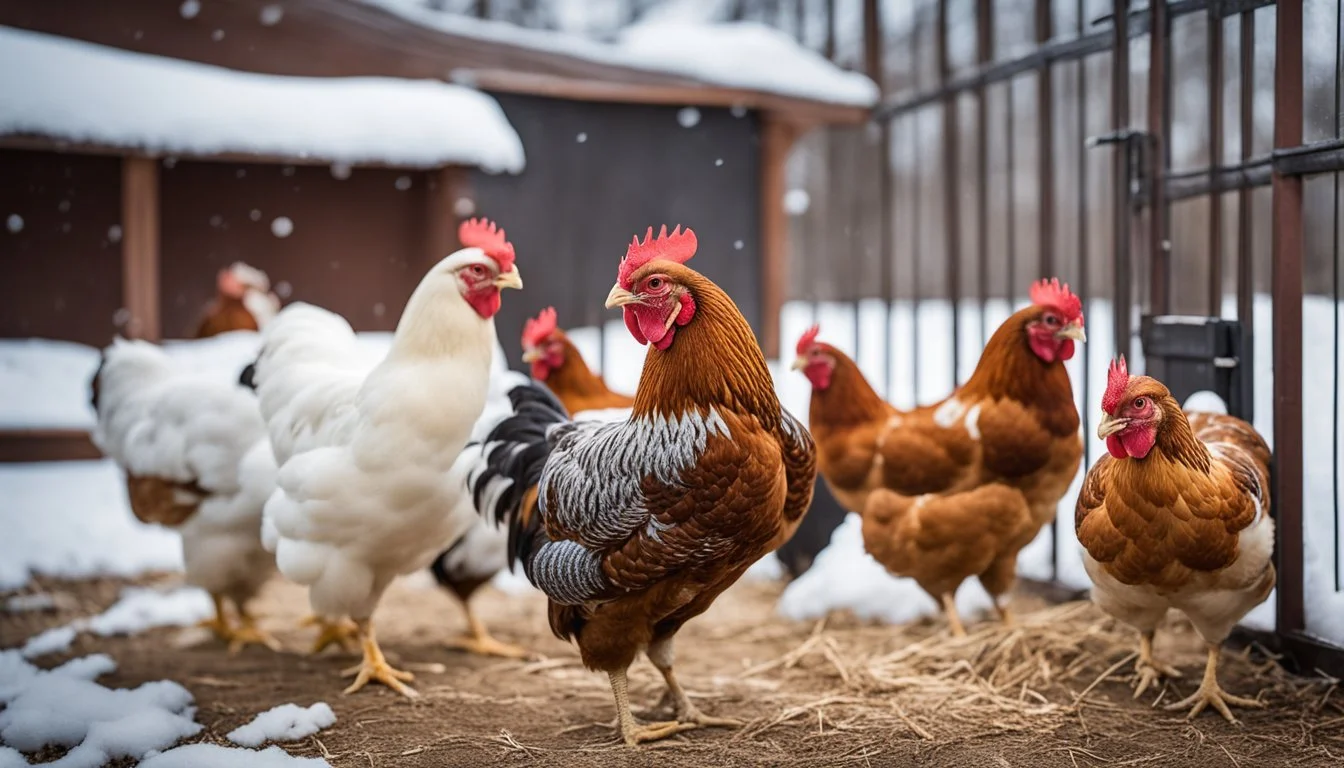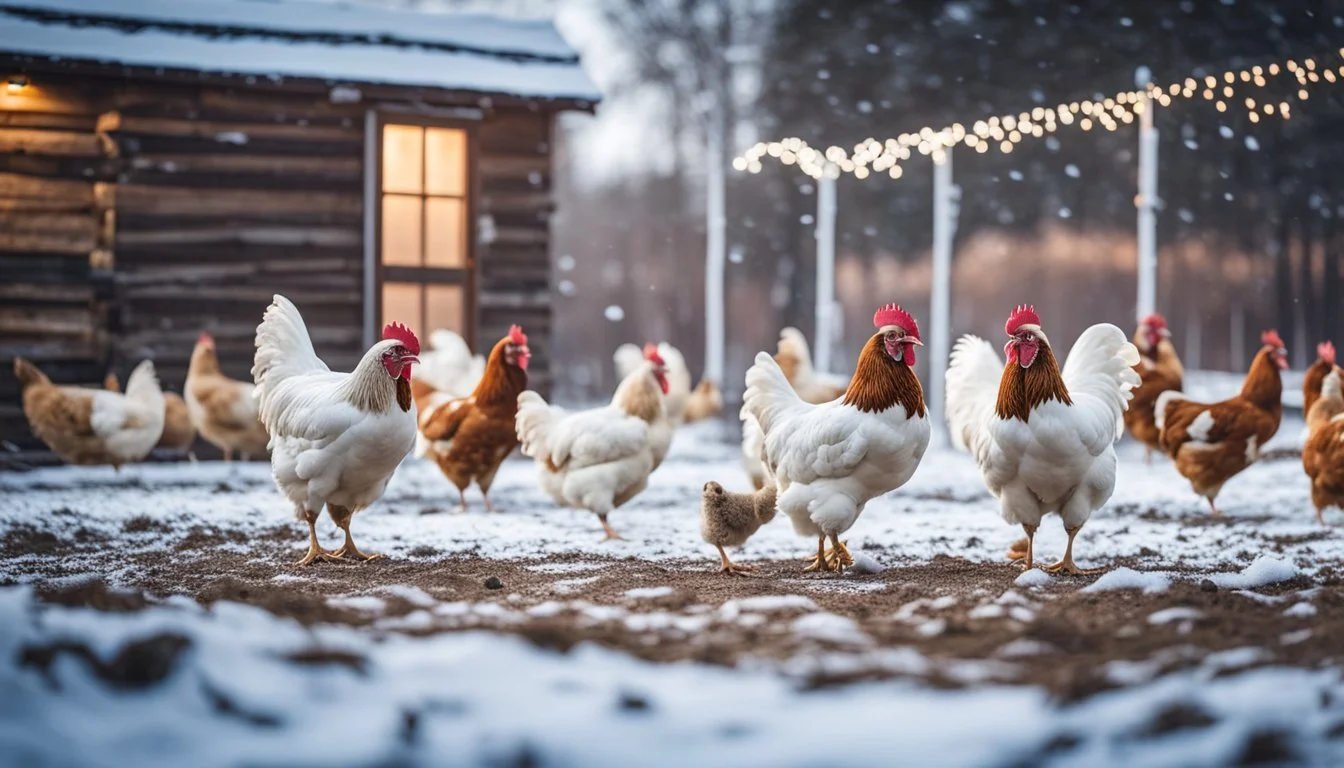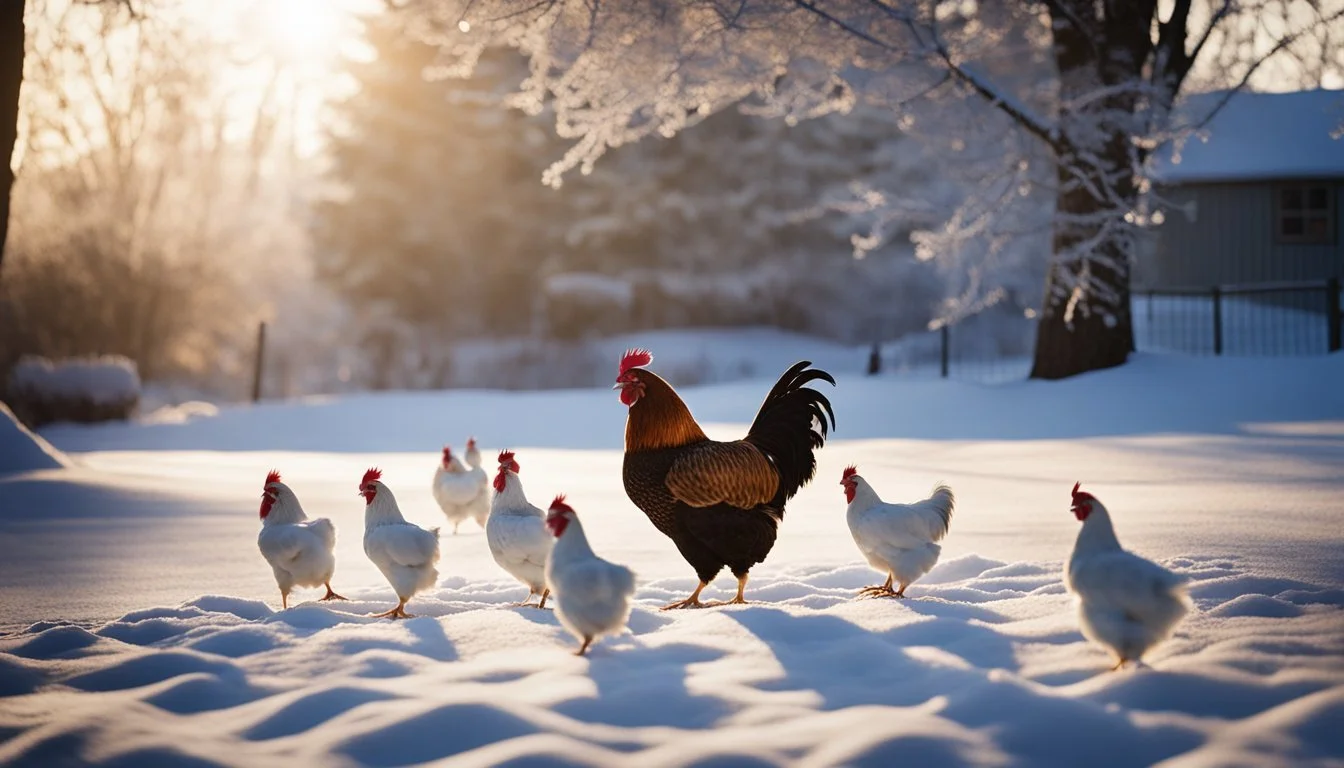7 Tips for Raising Chickens in Cold Climates
Expert Advice for Success
Raising chickens in cold climates poses unique challenges that can make it difficult to keep birds healthy and productive. Preparing for winter conditions with the right care strategies is crucial to ensure chickens remain comfortable, safe, and continue to thrive. This requires understanding how to manage their environment, diet, and general health during the colder months.
Many chicken breeds are well-suited for colder climates, and with thoughtful preparation, even those in harsh environments can maintain a healthy flock. This article will outline seven practical tips for raising chickens in cold climates, providing essential guidance to help your feathered friends thrive regardless of winter's severity.
1) Insulate the Coop Properly
Ensuring a chicken coop is well insulated is crucial for maintaining the health and comfort of chickens during cold weather. Start by sealing any cracks or gaps in the walls, floors, and around pipes with caulk or adhesive to prevent drafts.
Consider adding insulation materials like foam boards, fiberglass, or straw to the walls and ceiling. These materials help retain heat within the coop, keeping the temperature stable. It's also important to ensure ventilation is adequate without allowing cold drafts to enter.
Cover windows with plastic sheeting to minimize heat loss while still allowing light to enter. This simple step can help significantly in preventing your coop from becoming too cold.
Place roosts along the warmest side of the coop to provide a cozy resting spot for the chickens. A large, solid roost will help keep their feet warm, which is important in preventing frostbite.
Overall, a well-insulated coop creates a draft-free, warm environment, ensuring chickens remain healthy through the winter season. Proper insulation combined with good ventilation will lead to a more comfortable and safer habitat for the flock.
2) Provide Heated Waterers
One of the critical steps in raising chickens during cold climates is ensuring they have access to unfrozen water. Heated waterers can prevent water from freezing, making sure chickens stay hydrated.
A heated waterer keeps the water at a drinkable temperature without manual intervention throughout the day. This is particularly useful in areas where temperatures drop below freezing.
Maintaining access to liquid water is essential for chickens' health. They need water to digest their food and lay eggs. Dehydration can become a serious issue if their water source is frozen for too long.
In addition to using heated waterers, it's also beneficial to regularly check the water supply. Even the best heated waterers can occasionally fail, so it's wise to have a backup plan.
Choosing a heated waterer with a reliable thermostat can help manage and sustain the water temperature effectively. Look for models designed specifically for poultry to ensure they meet their needs.
Overall, heated waterers are a practical solution to a common winter challenge. By incorporating one, chicken keepers can provide their flock with a steady supply of fresh water regardless of the weather.
3) Choose Cold-Hardy Chicken Breeds
Selecting the right chicken breeds is crucial for thriving in cold climates. Certain breeds are more resilient to low temperatures due to their physical characteristics and genetic traits.
Ameraucana chickens are a prime choice. Known for laying medium-sized blue eggs, they have pea combs and small wattles that reduce the risk of frostbite.
Another excellent breed is the Wyandotte. These chickens are robust and come in various colors, such as silver-penciled and blue. Wyandottes are dual-purpose birds, known for their good egg production and meat quality.
The Rhode Island Red is also well-suited for cold weather. They are hardy birds that lay large brown eggs and possess a sturdy build, which helps them withstand chilly conditions.
Cochins, with their dense plumage and feathered legs, are another great option. Their thick feathers provide excellent insulation, keeping them warm during harsh winters.
Lastly, consider the Buff Orpington. They are known for their calm temperament and reliable egg laying. Their fluffy feathers keep them cozy, making them ideal for colder regions.
Choosing the right breeds ensures that your chickens remain healthy and productive throughout the winter months. Select cold-hardy breeds to maintain a thriving flock year-round.
4) Utilize Deep Litter Method
The deep litter method is an effective way for maintaining a healthy chicken coop during cold climates. Starting with a clean coop, make sure to remove old bedding and clean the space thoroughly. Once everything is clean and dry, add a base layer of carbon-rich bedding material such as pine shavings, straw, or wood chips.
Every week, add a new layer of bedding over the older material. This method allows for natural decomposition of chicken waste, which generates heat and keeps the coop warm. Stirring the bedding occasionally helps to aerate the composting process and distribute warmth evenly.
Using this method, the chickens' manure breaks down into useful compost over time. This compost not only provides insulation but also enriches the soil when used in the garden. It’s important to maintain a balance of moisture and dryness to avoid issues like ammonia buildup.
The deep litter method is more than just an insulating technique; it is also cost-effective. It reduces the need for frequent coop cleaning and bedding replacement. This method thus benefits both the chickens and the owners by simplifying maintenance and providing a sustainable way to handle waste.
5) Offer High-Energy Feeds
In colder climates, chickens require more energy to maintain body heat. Providing high-energy feeds is crucial for their health and productivity.
Increasing the protein content in their feed can help. Foods such as mealworms and sunflower seeds are excellent supplements.
Complete layer feeds that are specially formulated can ensure they get all the nutrients they need.
Frequent feedings help too. High-energy feeds give chickens the necessary fuel to stay warm during the winter months.
Use a variety of foods to keep them engaged and active. Mixing different grains and seeds can provide a balanced diet.
Keeping chickens well-fed with high-energy foods can ensure they stay warm and healthy despite the cold.
6) Ensure Good Ventilation
Proper ventilation is crucial for keeping chickens healthy in cold climates. It helps prevent moisture buildup, which can lead to frostbite and respiratory issues. A well-ventilated coop allows fresh air to circulate without letting in drafts.
Ventilation should be strategically placed. High vents are ideal as warm air rises. These vents can let out humidity while retaining heat.
Avoid placing vents near the roosting areas where chickens sleep. Direct drafts on chickens can cause discomfort and health problems. Ensure the ventilation system remains functional even during heavy snow or ice conditions.
Check for and fix any blockages regularly. Small holes can become clogged with frost, inhibiting airflow. Using larger vents or multiple smaller ones can mitigate this problem.
Keep the coop dry by removing wet bedding and ensuring waterers do not leak. Managing moisture at the source reduces the burden on ventilation systems, keeping the environment safe for chickens.
Regularly monitor the coop's humidity and temperature levels. Adjust the ventilation as needed to maintain a balance, ensuring the coop stays dry and warm.
7) Use Supplemental Lighting
Chickens require 14 to 16 hours of light daily to maintain consistent egg production. During winter, natural daylight is often insufficient, leading to a decrease in laying.
Adding artificial lighting in the coop can mimic longer days and stimulate egg production. Use a simple timer to control the lights, ensuring they turn on and off at consistent times.
Install a 40-watt bulb to provide supplemental lighting. Gradually extend the period of light exposure, starting with a few additional hours each day.
It's best to add light in the early morning rather than the evening. This approach avoids sudden darkness that could stress the chickens and disrupt their routine.
Ensure that lighting is safely installed to prevent any overheating or fire hazards. Securely mount light fixtures out of reach of the chickens to avoid accidents.
Preparing Your Coop
Creating a suitable coop for winter involves ensuring proper insulation, maintaining adequate ventilation, and implementing safe heating methods. Each of these aspects is crucial to keep your chickens healthy and comfortable during colder months.
Insulation Techniques
Insulating the chicken coop effectively helps to retain warmth. Use materials like foam boards, fiberglass, or reflective bubble insulation to line the walls and ceiling. Straw and wood shavings can be added to the floor for extra warmth. Ensure that the insulation is securely fastened to prevent chickens from pecking at it. Cover windows with clear plastic sheeting to reduce drafts while still allowing sunlight to enter. Consider using a thick litter, about 6-10 inches, as it provides excellent insulation for chickens to burrow into.
Ventilation Considerations
While keeping the coop warm is essential, adequate ventilation prevents moisture buildup, which can lead to respiratory problems. Design the coop with vents positioned high up, allowing moist air to escape without causing drafts at the chickens' level. Adjustable vents can be useful for regulating airflow. Installing a ridge vent or small windows at the top of the walls can help maintain proper air circulation. Remember to check for any leaks that might create unintended drafts and address them promptly. Good ventilation will ensure a healthy environment by keeping the air in the coop fresh and dry.
Safe Heating Solutions
To supplement the natural warmth provided by insulation and bedding, consider safe heating options. Heated waterers can prevent the chickens' water supply from freezing, ensuring they stay hydrated. When using electrical heaters or heat lamps, ensure they are specifically designed for poultry and have safety features like automatic shut-off. Avoid open flames or unsafe heating elements that could cause fires. Placement of heaters should be such that chickens cannot come into direct contact with them. Always monitor the coop's temperature, aiming to keep it comfortable but not so warm that chickens become stressed by sudden temperature fluctuations upon leaving the coop.
Properly preparing the coop will help keep the chickens happy and healthy through the winter.
Feeding Chickens in Winter
During winter, ensuring chickens have proper nutrition and fresh water is essential for their health and well-being. Addressing these specific needs maintains their energy levels and supports their overall health.
Nutritional Adjustments
In colder months, chickens expend more energy to stay warm, requiring diets higher in calories and protein. High-quality feed should be the foundation, ideally containing around 16-18% protein.
Supplement the diet with scratch grains to provide an extra energy source. Corn, oats, and barley work well. A handful spread in the coop encourages foraging and activity.
In addition to grains, provide leafy greens and vegetables. These offer necessary vitamins and minerals. Hang cabbages or offer grated carrots and squash, which can keep them entertained.
Providing Fresh Water
Fresh water is critical in winter, preventing dehydration and digestive problems. Waterers should be checked regularly and refreshed multiple times per day.
Using a heated waterer can prevent freezing and ensure a steady supply of water. Alternatively, rubber bowls are effective, as they can be de-iced easily by tapping out the ice buildup.
Adding apple cider vinegar in moderation can prevent bacterial growth and promote overall health. Warm water also encourages drinking, as chickens are more likely to consume water that is not ice-cold.
Health and Wellness
When raising chickens in cold climates, maintaining their health and wellness is crucial. This involves preventing frostbite and closely monitoring their behavior to detect any signs of stress or illness.
Preventing Frostbite
Frostbite is a common issue for chickens exposed to freezing temperatures. To prevent this, insulate the coop effectively with materials like straw, foam boards, or bubble wrap. Ensure it is ventilated to minimize moisture buildup, which can exacerbate frostbite.
Apply petroleum jelly to their combs and wattles as an additional protective measure. Keep waterers inside the coop to prevent water from freezing and causing cold exposure when chickens drink.
Perches should be wide enough for chickens to cover their toes with their feathers to keep them warm. Proper bedding management is also key, as damp or soiled bedding can freeze and harm their feet.
Monitoring Chicken Behavior
Observing chicken behavior during cold weather can provide early signs of health issues. Chickens may huddle together for warmth, but excessive huddling can indicate they are too cold. If chickens seem lethargic or shiver frequently, it suggests that their environment may be too chilly.
Watch for feathers that look fluffed up unusually, which can be a sign they are trying to trap extra heat. Keep an eye on feed and water consumption; reduced intake can signal health problems.
Conduct regular health checks to ensure they maintain body weight and do not develop cold stress conditions. Monitor foot raising behavior; if one foot is often tucked into their feathers, this might indicate discomfort due to cold surfaces.




